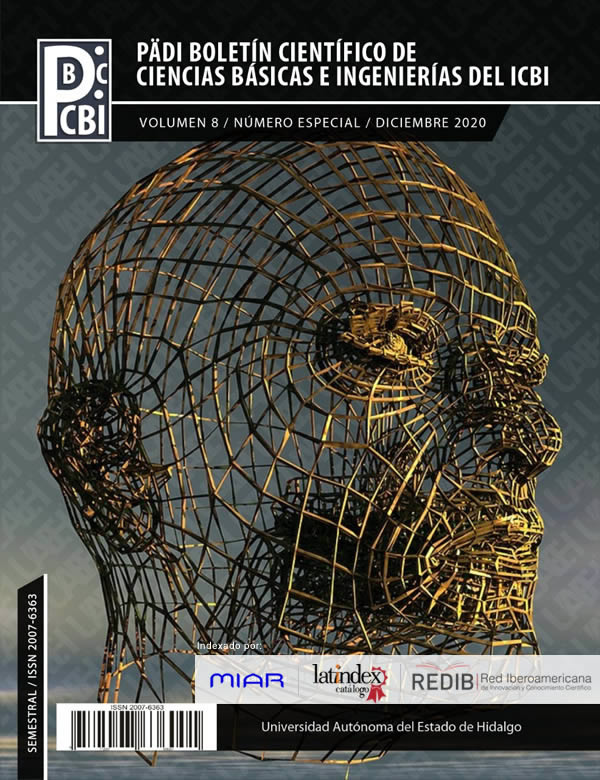Synthesis of Ceramic Nanocomposites-NTC from mining waste
Abstract
In this research, the use of accumulated mining waste is studied in the city of Mineral de La Reforma, Hidalgo, Mexico. The study presents the management and treatment of these wastes in order to increase their melting point, the obtaining of a mixture of SiO2 / Al2O3 phases of high purity and the synthesis of ceramic nanocomposites-multi-walled carbon nanotubes (NTCMP). The nanocomposite is prepared by size classification, leaching, mixing with NTCMP and densification under a nitrogen atmosphere at 1400 ° C. The samples were analyzed by X-ray diffraction, X-ray fluorescence, optical, scanning and transmission microscopy. The results show that the leached powders have a ceramic phase mainly of SiO2 / Al2O3 greater than 91% by mass; 43% increase in the melting point with respect to the original powders, homogeneity between the ceramic particles - NTC and a densification of the nanocomposite of 88%.
Downloads
References
Servicio Geológico Mexicano (2018), Anuario Estadístico de la Minería Mexicana, 2015, México, SGM.
Gómez Bernal J. M., Santana–Carillo J., Romero–Martin F., Armienta–Hernández M. A., Morton–Bermea A. & Ruiz–Huerta E. A.. (2010). Plantas de sitios contaminadoscon desechos mineros en Taxco, Guerrero, México. Boletín de la Sociedad Botánica de México, 87, 131-133.
Belmonte Serrato F., Romero Díaz A. & Moreno Brotóns J. (2010). Contaminación ambiental por estériles mineros en un espacio turistico en desarrollo, la sierra minera de Cartagena-La unión (sureste de España). Cuadernos de Turismo, 25, 11-24.
Hernández-Acosta, E., Mondragón-Romero, E., Cristobal-Acevedo, D., Rubiños-Panta, J. E., & Robledo-Santoyo, E. (2009). Vegetación, residuos de mina y elementos potencialmente tóxicos de un jal de Pachuca, Hidalgo, México. Revista Chapingo serie ciencias forestales y del ambiente, 15(2), 109-114.
Moreno-Tovar, R., Barbanson, L., & Coreño-Alonso, O. (2009). Neoformación mineralógica en residuos mineros (jales) del distrito minero Zimapán, estado de Hidalgo, México. Minería y Geología, 25(2), 31.
Hernández, J., Rivera, I., Patiño, F., & Juárez, J. C. (2013). Estudio Cinético de la Lixiviación de Plata en el Sistema S2O3(2-)-O2- Cu2+ Contenido en Residuos Minero-Metalúrgicos. Información tecnológica, 24(1), 51-58.
DOI: 10.4067/S0718-07642013000100007
Zamora, R. M. R. (2017). Síntesis de zeolitas a partir de jales de cobre para la remoción de metales y amonio presentes en agua. Gaceta Instituto de Ingeniería, UNAM, 1(68), 16-y, Cuidad de México, México.
Castro-Gomes J.P, Silva A., Cano R., Durán Suárez J. & Albuquerque A.. (2011, diciembre 13). Potential for reuse of tungsten mining waste-rock in technical-artistic value added products. Journal of Cleaner Production, 25, 34-41. 2020, Julio 12, De ScienceDirect Base de datos.
DOI:10.1016/j.jclepro.2011.11.064
Naranjo, T., & Isabel, O. (2010). Optimización del proceso de cocción en la producción de ladrillos de cerámica roja en el cantón Chambo (Bachelor's thesis).
Gómez S. (2018). Materiales nanoestructurados de zirconia: Materiales densos y compositos con nanotubos de carbono (NTC). Tesis Doctoral. Universidad Nacional De La Plata, La Plata, Argentina.
Peigney, A., Garcia, F. L., Estournes, C., Weibel, A., & Laurent, C. (2010). Toughening and hardening in double-walled carbon nanotube/nanostructured magnesia composites. Carbon, 48(7), 1952-1960.
DOI: 10.1016/j.carbon.2010.01.063
Alvarez Escobar, S. P. Recubrimientos vítreos silíceos con partículas bioactivas de wollastonita y nanotubos de carbono obtenidos por la técnica sol-gel y depositados sobre acero inoxidable 316L. Maestría thesis, Universidad Nacional de Colombia - Sede Medellín.
Romero M. & Rincón J. M. (1997). Obtención y caracterización de vidrios obtenidos a partir de residuos industriales de goethita (FeOOH). Boletín de la Sociedad Española de Cerámica y Vidrio, 36 (1), 39-46.
Longhi A., Rodríguez E., Bernal S. & Provis J.. (2015, diciembre 23). Valorisation of a kaolin mining waste for the production of geopolymers. Journal of Cleaner Production, 115, 265-272. 2020, Julio 12.
DOI: 10.1016/j.jclepro.2015.12.011
Vegas I., Cano M., Arribas I., Frías M., & Rodríguez O.. (2015). Physical–mechanical behavior of binary cements blended with thermally activated coal mining waste. Construction and Building Materials, 99, 169-174.
DOI: 10.1016/j.conbuildmat.2015.07.189
Zamorano, L. G., Escalante, J. I. (2009). Hidratación y microestructura de cemento Portland sustituido parcialmente con sílice ultra fina. Materiales de construcción, 296, 5-16.
Doi: 10.3989/mc.2009.46108
Nixon, R. A. (1979). Differences in incongruent weathering of plagioclase and microcline—Cation leaching versus precipitates. Geology, 7(4), 221-224.
DOI: 10.1130/0091-7613(1979)7<221:DIIWOP>2.0.CO;2
Klein, C., Cornelius, S., (1996). Manual de Mineralogía. Reverté, Barcelona, España.
Coordinación General de Economía, Dirección General de desarrollo Minero, Perfil de Mercado del Sílice, 13-19.
G. F. Terry Lay & Maria C. Rockwell. (2009). Characteristics of silicate glasses derived from vitrification of manganese crust tailings. Ceramics International
DOI: 10.1016/j.ceramint.2008.10.035













